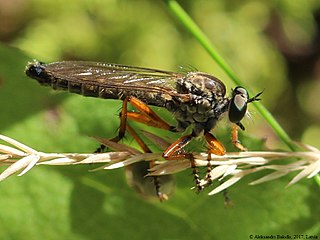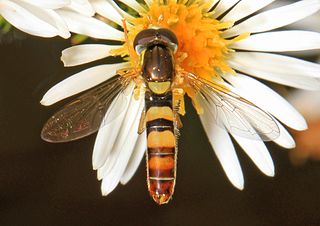
Flies are insects of the order Diptera, the name being derived from the Greek δι- di- "two", and πτερόν pteron "wing". Insects of this order use only a single pair of wings to fly, the hindwings having evolved into advanced mechanosensory organs known as halteres, which act as high-speed sensors of rotational movement and allow dipterans to perform advanced aerobatics. Diptera is a large order containing an estimated 1,000,000 species including horse-flies, crane flies, hoverflies, mosquitoes and others, although only about 125,000 species have been described.

A crane fly is any member of the dipteran superfamily Tipuloidea, which contains the living families Cylindrotomidae, Limoniidae, Pediciidae and Tipulidae, as well as several extinct families. "Winter crane flies", members of the family Trichoceridae, are sufficiently different from the typical crane flies of Tipuloidea to be excluded from the superfamily Tipuloidea, and are placed as their sister group within Tipulomorpha.

A midge is any small fly, including species in several families of non-mosquito nematoceran Diptera. Midges are found on practically every land area outside permanently arid deserts and the frigid zones. Some midges, such as many Phlebotominae and Simuliidae, are vectors of various diseases. Many others play useful roles as prey for insectivores, such as various frogs and swallows. Others are important as detritivores, and form part of various nutrient cycles. The habits of midges vary greatly from species to species, though within any particular family, midges commonly have similar ecological roles.

The Tephritidae are one of two fly families referred to as fruit flies, the other family being the Drosophilidae. The family Tephritidae does not include the biological model organisms of the genus Drosophila, which is often called the "common fruit fly". Nearly 5,000 described species of tephritid fruit fly are categorized in almost 500 genera of the Tephritidae. Description, recategorization, and genetic analyses are constantly changing the taxonomy of this family. To distinguish them from the Drosophilidae, the Tephritidae are sometimes called peacock flies, in reference to their elaborate and colorful markings. The name comes from the Greek τεφρος, tephros, meaning "ash grey". They are found in all the biogeographic realms.

A black fly or blackfly is any member of the family Simuliidae of the Culicomorpha infraorder. It is related to the Ceratopogonidae, Chironomidae, and Thaumaleidae. Over 2,200 species of black flies have been formally named, of which 15 are extinct. They are divided into two subfamilies: Parasimuliinae contains only one genus and four species; Simuliinae contains all the rest. Over 1,800 of the species belong to the genus Simulium.

Campiglossa is a genus of fruit flies in the family Tephritidae. There are at least 190 described species in Campiglossa.
Parastenopa is a genus of fruit flies in the family Tephritidae. There are about 10 described species in Parastenopa.

Toxonevra muliebris is a species of flutter fly in the family Pallopteridae. It has been found in Europe and North America. The pattern on the wings of this species is distinctive.
Dilophus strigilatus is a species of March fly in the family Bibionidae.
Prosimulium mixtum, the mixed-up black fly, is a species of black flies.

Clusia occidentalis is a species of fly in the family Clusiidae. It is found on the west coast of Canada and the United States of America, where it is the only known species of Clusia.

Lucilia cluvia is a species of blow fly in the family Calliphoridae.

Lucilia eximia is a species of blow fly in the family Calliphoridae.

Mallophora fautrix is a species of robber fly in the family Asilidae.

Minettia fasciata is a species of fly in the family Lauxaniidae.

Neomochtherus pallipes, the Devon red-legged robber fly, is a species of robber fly in the family Asilidae.

Opomyza germinationis is a species of fly in the family Opomyzidae.

Sphaerophoria contigua is a species of syrphid fly in the family Syrphidae. It is a predator of aphids.

Toxonevra is a genus of flutter flies in the family Pallopteridae. There are about eight described species in Toxonevra.

Zaprionus indianus, the African fig fly, is a species of vinegar fly in the family Drosophilidae.



















